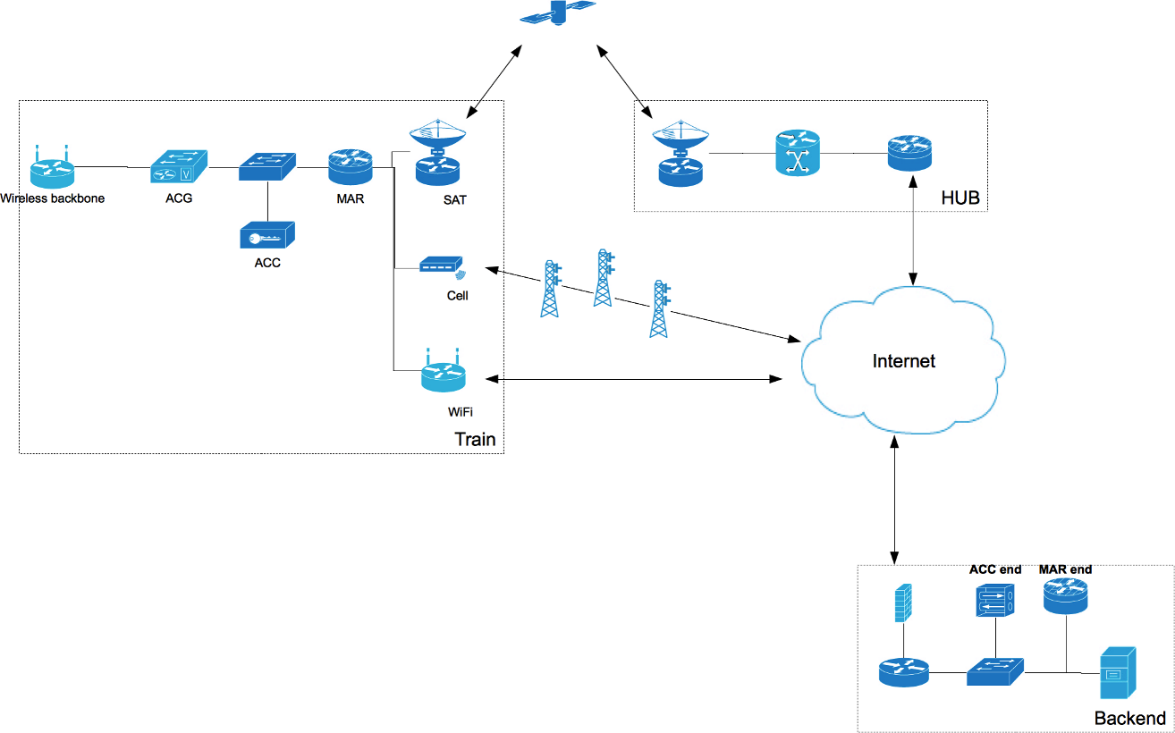EOMST
Programme |
Activity |
Status |
Thematic areas |
|---|---|---|---|
Ongoing |
Broadband to passengers |
The goals of the project are:
1) To improve users ‘experience of the current system by optimizing the bandwidth usage
2) Use a more efficient satellite technology permitting the use of the Adaptive Coding and Modulation (ACM) in both the forward link and the return link
3) Improve reacquisition time of the satellite system (modem) after long shadow zones
4) Develop a more robust TCP and HTTP acceleration system able to handle link with high delays but also to cope with the type of traffic generated by the users
5) Implement Quality of Service (QoS) management in order to filter unwanted traffic
6) Aggregate links of different nature (delays) in order to make them acting as one single link, getting away as much as possible the link per link management
SERVICE/SYSTEM CONCEPT
The system is composed of three key subsystems: the communication element in the train, the HUB and the backend.

The train subsystem is composed of:
- The wireless backbone
- The ACG: Access Control Gateway, It provides major functionalities to permit the customers to access the system
- The MAR: Mobile Access Router managing the access technologies
- The ACC: The Accelerator optimizes the TCP IP connection efficiency even with high latency link
- The Satellite modem/Cell/WiFi: used for the connections towards the Internet
The back end is composed of the coupled element of the MAR and the ACC.
The project is addressing the following features:
- Migrate from the current Constant Coding and Modulation (CCM) of DVB-RCS transmission system to the Adaptive Coding and Modulation (ACM) scheme, in order to provide more bandwidth and more cost effectively transmission
- Improve the performance of DVB-RCS in the harsh railway environment
- Develop a new Mobile Access Router that will convey the data packets from the train towards the Internet through link with heterogeneous end-to-end delay, maximizing the utilization of each of the available link
The MAR implementation has been performed in three successive stages:
MAR 2.0: To bond link of the same nature (cellular, WiFi)
MAR 3.0: To bond link of different nature (satellite, cellular, WiFi) using a packet switching technology
MAR 4.0 To bond link of different nature (satellite, cellular, WiFi) making a major step forward in terms of performance. MAR 4.0 embodies all the experience accumulated over the EOMST experimentation and testing in live conditions. It integrates packet-switching through a Multipath TCP (MPTCP) with major improvements based on TCP tunneling between TCP proxies residing at both ends of each link.
USERS AND THEIR NEEDS
Users targeted are in Belgium/France/Netherlands and Germany (Thalys) and U.K (Caledonian Sleepers)
SPACE ADDED VALUE
Satellite communications complement the use of mobile network technologies increasing the availability and offering competitive solutions complementing terrestrial technology or replacing it when not available.
STATUS
In the first project phase was successfully held on a train of the Thalys fleet between the April 2014 and May 2014. The results confirmed the correct functioning of the system. The availability of the service has increased by 5%. The biggest improvement has been made on the routes with a better cellular coverage. This shows that the bonding (only available between links of identical nature) technology helps significantly to increase service availability. The offered average bandwidth on trains has also been increased by 30%. Eventually the price of the satellite capacity had also decreased thanks to the more efficient satellite technology (ACM).
A second pilot was successfully held on a train of the Thalys fleet between October 2015 and January 2016. With a system availability average of 99%, the pilot was demonstrating that the new system is capable to satisfy the expectations of the customer in terms of Internet availability. The data collected during this time have shown a very good performance of the Internet Service on Thalys trains with values in most of the cases steadily over target. The results confirm the good working of the system. The bonding (working between links of different nature) technology helped significantly to increase the service availability compared to previous solutions. The offered average bandwidth on train has also been increased.
In the third phase of the project an enhanced Mobile Access Router (MAR 4.0) is under design. The project has passed the Baseline Design eview (BDR) in October 2016. A trial on a Caledonian Sleepers train is expected in Summer 2017.
See project page details:
EOMSTCONTRACTORS
Belgium
SUBCONTRACTORS
PROJECT MANAGERS
CONTRACTOR PROJECT MANAGER
Isidro
Arroyo Gahete
21Net 350 Leuvenstesteenweg
3190
Boortmeerbeek
BE
ESA PROJECT MANAGER
Michele
Castorina
ESTEC
2200 AG
Noordwijk
NL
Last updated date: 13 December 2023


